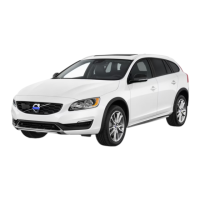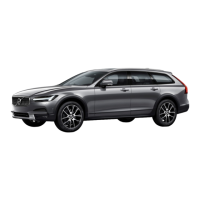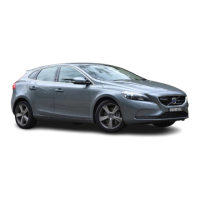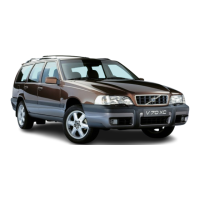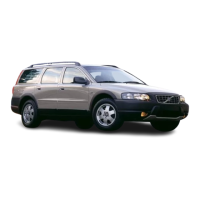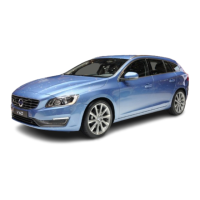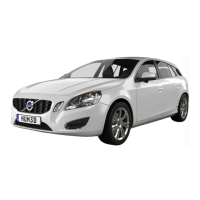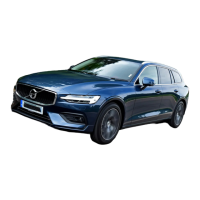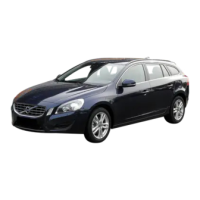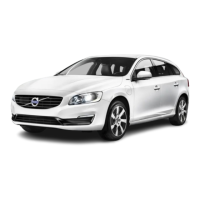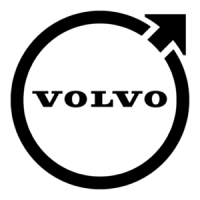
Do you have a question about the Volvo V60 CROSS COUNTRY 2018 and is the answer not in the manual?
| Brand | Volvo |
|---|---|
| Model | V60 CROSS COUNTRY 2018 |
| Category | Automobile |
| Language | English |
Availability of owner's info in printed, digital, display, app, and web formats. Printed supplement in glovebox.
Digital manual accessed via center display top view. Searchable with visual navigation.
How to access and navigate digital manual via center display views, home page, and top menu.
Manual available as a mobile app from App Store/Google Play, with video tutorials and search functionality.
Online resource for manuals, video tutorials, and car ownership help via support.volvocars.com.
Recommends reading manual for familiarity with functions, advice on car handling, and optimal feature use.
Manual printed on paper from controlled forests, FSC certified.
Personal ID for access to Volvo services via a single username/password. Services vary by market/equipment.
Steps to create a Volvo ID via the Volvo ID app, website, or Volvo On Call app and register it.
Volvo's focus on safer, more efficient products to reduce environmental impact and improve drivelines.
Volvo's concept for car safety, comprising systems to make journeys safer and protect occupants/road users.
Intelligent interface and online connectivity with digital world for apps, entertainment, and navigation.
Information on developing systems and services, with updates available via authorized Volvo dealers.
Vehicle operation, functionality, and incidents recorded via EDR for accident analysis and system monitoring.
Volvo offers services for safe and comfortable driving, including assistance, navigation, and maintenance.
Policy on handling customer data and personal information, outlining gathering, processing, and handling practices.
Incorrect connection/installation of accessories can affect the car's electronic system. Recommends Volvo-approved accessories installed by technicians.
Recommends Volvo original accessories installed by trained technicians. Explains testing, knowledge, and advice from technicians.
Incorrect connection/installation of software/diagnostic tools can affect the car's electronic system.
Finding the VIN via settings in the centre display or on the dashboard/service booklet/registration certificate.
Driver responsibility for safety, avoiding distractions. Warns against using devices while driving.
Vehicle equipped with safety systems (sensors, airbags, tensioners) working together for protection in accidents.
Importance of correct seatbelt use during pregnancy and adjusting seating position.
WHIPS reduces whiplash injuries via energy-absorbing backrests, seat cushion, and head restraint.
PPS mitigates pedestrian impact in frontal collisions via bonnet raising and automatic alarm.
Heavy braking consequences if seatbelts aren't used. Importance of proper body fit and avoiding twists.
Instructions for fastening seatbelts correctly, including height adjustment for front seats.
Car fitted with standard and electric tensioners to tension seatbelts in critical situations/collisions.
Procedure to reset electric seatbelt tensioner manually if belt remains extended.
System reminds unbelted occupants and warns about open doors, bonnet, or lid.
Car equipped with airbags and inflatable curtains for driver and passengers.
Supplement to seatbelts, includes steering wheel airbag and knee airbag on driver's side.
Supplement to seatbelts, vehicle equipped with airbag on passenger side in front seat.
Passenger airbag can be deactivated via switch if equipped. Explains ON/OFF positions and warnings.
Side airbags on driver's/passenger seats protect chest and hips in collisions. Fitted in outer backrest frames.
IC prevents driver/passengers from striking heads in collision. Mounted along headlining.
Protective state triggered when collision may have damaged vital functions (fuel lines, sensors, brake system).
Procedure to attempt resetting system for short distance movement after safety mode activation.
Children must sit securely. Recommends rear-facing seats until 3-4 years, then front-facing until 140 cm tall.
Suitable child seats should be used. Ensure correct positioning, mounting, and use.
Car equipped with upper mounting points on rear seat outer seats, primarily for front-facing seats.
Car equipped with lower mounting points in front and rear seats, designed for certain rear-facing seats.
Car equipped with i-Size/ISOFIX mounting points in rear seat, based on international standard.
Front seats have setting options for comfort: adjust cushion length, forward/backward, backrest inclination, lumbar support.
Power seat adjustment for comfort: forwards/backwards, upwards/downwards, cushion length, backrest inclination, lumbar support.
Store two different positions for power seat, door mirrors, and head-up display using memory buttons.
Activate stored positions using memory buttons by short or long press.
Massage function adjustable via multi-function control or centre display with programs (Swell, Tread, Lumbar) and intensity/speed settings.
Adjust massage settings via multi-function control or centre display. Range of settings shown.
Adjust seat cushion length using multi-function control or manual lever on front of seat cushion.
Adjust backrest sides for side support using multi-function control or centre display.
Adjust lumbar support using control on seat cushion side (up/down/forward/back) or round button.
Adjust passenger seat from driver's seat via function view in centre display, within 10 seconds.
Rear seat backrests divided into two parts, can be folded forward individually via electronic or manual controls.
Adjust centre seat head restraint for passenger height. Fold down outer head restraints for better rearward visibility.
Steering wheel houses controls for driver support systems, voice recognition, menu, message, phone handling, and the horn.
Mechanical lock to deter theft. Activated when car is locked/engine off. Deactivated by unlocking/starting.
Adjust steering wheel height and depth. Different methods for cars with/without knee airbag.
Electronic climate control system cools, heats, and dehumidifies air. Functions controlled via centre display and console buttons.
Number of climate zones determines options for setting different temperatures for passenger compartment parts.
Climate control uses sensors (sun, moisture, temp, air quality) to control climate. Do not cover sensors.
Climate control regulates perceived temperature based on factors like ambient temp, air speed, humidity, solar radiation.
Voice commands for changing temp, activating heated seats, and fan levels, e.g., "Set temperature to X degrees".
Selected materials and air cleaning system ensure high passenger compartment air quality. Includes Clean Zone Interior Package and IAQS.
Function checks and indicates conditions for good air quality. Indicator visible in climate view, changes to blue when conditions met.
Modifications to keep compartment clearer from allergy/asthma substances, includes enhanced fan function and IAQS.
IAQS separates gases/particles to reduce odours/contaminants. Closes air intake if outside air is contaminated.
Air quality sensor can be activated/deactivated. Recommended to keep enabled for best air.
All air entering compartment is cleaned by a filter. Filter replacement at regular intervals or more often in contaminated environments.
Climate control distributes air via vents. Auto-regulated distribution is automatic, manual control is possible.
Air distribution can be changed manually via climate view by pressing symbol.
Air vents in instrument panel, door pillars, and tunnel console can be opened, closed, and aimed individually.
Table lists air distribution options and their purposes for different climate conditions.
Functions controlled by console buttons, centre display, and rear tunnel console controls. Includes heated seats/steering wheel, auto climate.
Seats can be heated for comfort in cold. Four levels: Off, High, Medium, Low. Warning for people with reduced sensation.
Set whether automatic start of heated seats is activated/deactivated when engine starts. Heating starts in low ambient temperature.
Heated rear seats can be activated/deactivated via climate panel or physical buttons.
Seats can be ventilated for comfort in hot climate. Fans in seats/backrests draw air. Activated when engine is running.
Steering wheel can be heated for comfort in cold. Four levels: Off, High, Medium, Low.
Set whether automatic start of heated steering wheel is activated/deactivated when engine starts.
With auto climate control activated, multiple climate functions are controlled automatically.
Air recirculation shuts out bad air, exhaust gases, etc. Reuses air in passenger compartment. Risk of misting if used too long.
Set whether air recirculation timer should be activated/deactivated. Switched off automatically after 20 minutes.
Max defroster quickly removes mist and ice from windows. Deactivates auto-regulation, activates AC, sets fan to Max, temp to HI.
Heated windscreen quickly removes mist and ice. Activated/deactivated via console button or centre display.
Set whether automatic start of heated windscreen is activated/deactivated when engine starts. Heating starts in risk of ice/misting.
Heated rear window and door mirrors quickly remove mist and ice. Activated/deactivated via console button.
Set whether automatic start of heated rear window/door mirrors is activated/deactivated when engine starts.
Set fan speed for front seat via climate view. Levels Off, 1-5, Max.
Set fan speed for rear seat via Rear climate tab. Can be switched off by tapping 2nd row climate.
Set desired temperature for front seat climate zones via climate row buttons.
Set desired temperature for rear seat climate zones via Rear climate tab or rear seat console buttons.
Synchronise temperatures for all climate zones with driver's side. Stopped by further press or changing zone temp.
Air conditioning cools and dehumidifies incoming air. Automatically controls starting/switching off. Close side windows/panoramic roof for optimal function.
Generic term for functions improving passenger compartment climate when parked, e.g., preconditioning.
Climate function to reach comfort temperature before departure. Use direct start or set via timer.
Controls for exterior and interior lighting. Left-hand stalk switch for exterior, thumbwheel for interior brightness.
Adjust/activate light functions (main beam, home safe, approach light) via centre display.
Reset headlamp pattern for traffic (RHD/LHD) to adapt beam and avoid dazzling oncoming traffic.
Position lamps switched on with rotating ring for visibility when stopped/parked. Number plate lighting also on.
DRLs switched on by stalk switch in AUTO/ or position. Headlamps automatically dip in weak daylight/darkness.
Dipped beam activated automatically in weak daylight/darkness or ignition position II. Also activated if fog lamps are on.
Main beam is car's strongest lighting for dark driving. Used as long as it does not dazzle other road users.
Uses camera sensor to detect oncoming traffic/vehicle lights, switching between main and dipped beam.
Operated by left-hand stalk switch. Flash three times or continuously depending on movement.
Designed for bends/junctions, providing maximum illumination. Uses LED headlamps for adaptive functionality.
Front fog lamps emit stronger beam than dipped beam, effective in fog. Cornering lights illuminate area diagonally.
Stronger than normal rear lights, used in reduced visibility (fog, snow, smoke, dust) for early warning.
Brake light comes on automatically during braking when pedal is depressed or auto-braked by driver support.
Activated to alert vehicles behind about heavy braking via flashing brake light.
Warns other road users by activating all direction indicators simultaneously for traffic hazards.
Exterior lighting kept on after car is locked for home safe lighting. Activated/deactivated via centre display.
Approach lighting switches on when car is unlocked, used for lighting at a distance. Activated/deactivated via centre display.
Interior lighting improves experience, includes reading lamps, glovebox, ground lighting. Can be switched on/off manually.
Interior lighting varies by ignition position. Adjustable via thumbwheel and centre display.
Car contains controls for windows, glass, and mirrors. Some of the windows in the car are laminated.
Windscreen has laminated glass, optional for other areas. Reinforced for break-ins and sound insulation.
Power windows/sun blinds have pinch protection that deploys if blocked by an object during opening/closing.
If fault arises with pinch protection, a reset sequence can be tested. Starter battery disconnection requires reset.
Operated using control panels in doors. Driver's door has controls for all windows and child safety locks.
Operate power windows manually or with auto function. Cannot be opened above 180 km/h, but can be closed.
Used for better rear visibility. Interior mirror adjusted manually, can have HomeLink, dimming, compass. Door mirrors adjusted with joystick.
Dims mirrors to avoid dazzling. Manual dimming via control. Automatic dimming is always active.
Set mirror preferences for visibility. Automatic settings linked to memory buttons. Angling during parking (downward angle).
Divided into two glass sections. Front section opens vertically or horizontally. Wind deflector and sun blind provide extra protection.
Operated with roof panel control. Equipped with pinch protection.
Sun blind closes automatically 15 mins after car is locked in hot weather to protect upholstery.
Wipers/fluid clean windscreen/headlamps for visibility. Info on washer fluid topping up appears in driver display.
Clean windscreen. Settings set using right-hand stalk switch for sensitivity/frequency.
Automatically starts wipers based on detected water. Sensitivity adjusted via thumbwheel.
Memory function for rain sensor can be activated so button not needed each time car started.
Clean windscreen/headlamps. Started using right-hand stalk switch. Headlamp washing is automatic.
Engaging reverse gear with wipers on initiates rear window wiping. Stops when reverse gear disengaged.
Brakes applied automatically after collision to prevent/reduce effects of subsequent collision.
Part of powertrain, changes gear ratio based on speed/requirements. Eight-speed automatic, manual gearshift mode available.
System chooses optimal gear. Manual gearshift mode available. Shows current gear/next recommended gear.
Steering wheel paddles complement gear selector for manual gear changes without releasing hands.
Prevents accidental changing between gear positions in automatic gearbox. Mechanical and automatic types.
Automatic inhibitor can be disengaged if no power to car (e.g., discharged battery) to move gear selector to N.
Used for maximum acceleration/overtaking. Lower gear engaged when accelerator pedal fully depressed.
Shows current gear in manual shifting and when to engage next gear for optimum fuel economy.
AWD drives all four wheels for improved traction. Distributes motive force to wheels with best grip. Stabilizing effect at higher speeds.
Select drive mode (Eco, Comfort, Dynamic, Individual) to affect driving characteristics for experience/special situations.
Change drive mode using control in centre console. Not all modes available in all situations.
Optimises driving for fuel efficiency/environmental consciousness. Adapts gearbox, engine response, climate settings.
Function button in centre display (or tunnel console control) activates/deactivates Eco mode. Shows ECO indicator.
Engine braking ceases when accelerator pedal released, using kinetic energy to freewheel. Best for downhill gradients/predictable speed reductions.
Activated when accelerator pedal fully released, Eco drive mode active, gear selector in D, speed 65-140 km/h, downhill gradient <6%.
Freewheel function not available if engine/gearbox not at normal temp, gear selector not in D, speed outside range, steep downhill, or manual gear change.
Deactivate/switch off for engine braking (steep descents, overtaking). Actuate brake/accelerator, change gear, switch off Eco mode.
When using CC in Eco mode, acceleration/deceleration is lower for fuel savings. Speed may slightly deviate from set speed.
Indicates fuel efficiency. Low value in green zone for efficient driving, high value for less efficient driving.
Engine switches off temporarily when stationary, restarts automatically when journey resumes. Reduces fuel consumption/emissions.
Start/Stop temporarily switches off engine when stationary, restarts automatically when journey resumes. Available if conditions met.
Lists numerous conditions for engine not auto-stopping or auto-starting (speed, seatbelt, temp, obstacles, etc.).
Engine stops automatically when car stationary (foot brake) or sometimes before full stop in Comfort/Eco mode or with ACC/Pilot Assist.
Engine auto-starts in specific conditions (high humidity, temp deviation, low battery, repeated brake pedal use, bonnet open).
Engine auto-starts on brake pedal release. HSA engages on uphill. Delayed autostart if Auto Hold active or ACC/Pilot Assist active.
Car indicates locking/unlocking with hazard flashers and door mirror retraction/extension.
Select options for car's locking/unlocking confirmation in centre display settings.
Locks/unlocks doors, tailgate, fuel flap. Needs to be inside car for starting. Keyless starting (Passive Start) standard.
Buttons on remote key lock/unlock doors, tailgate, fuel flap. Long press closes windows/panorama roof.
Select sequences for remotely controlled unlocking (All Doors or Single Door).
Unlock just tailgate by pressing button. Power tailgate opens automatically when button held.
Key must be within certain distance (approx. 20m/65ft) from car for manual use.
Battery needs replacement when discharged. Information symbol and message shown in driver display.
Car supplied with two keys. Up to twelve keys can be programmed. Additional keys can be ordered.
Allows owner to set limitations for car properties (speed, volume) for safer driving when loaned out.
Regular key holder can change settings for Red Key. Driver support functions always active.
Key contains detachable blade for manual activation of functions and operations.
Key blade used to unlock car from outside if remote key battery discharged. Left-hand front door has lock cylinder.
Theft protection system preventing unauthorized start. Car starts only with correct remote control key.
Type approval for remote key system shown in tables for country/area.
With keyless locking/unlocking, carrying remote key suffices. Locked/unlocked via touch-sensitive surface on door handle.
Touch door handle's surface to lock/unlock car. Remote control key must be within range.
Select sequences for Keyless entry (All Doors or Single Door).
Touch tailgate handle's surface to unlock tailgate. Requires remote key within range behind car.
Antenna locations for keyless starting/locking systems built into car.
Doors/tailgate locked/unlocked from inside using central locking controls in front doors.
Tailgate unlocked from inside by pressing button on instrument panel.
Child safety locks prevent rear doors opening from inside. Can be manual or electric.
Doors and tailgate locked automatically when car starts to move.
Tailgate opens/closes at touch of button (remote key, instrument panel, light press on handle, foot movement).
Adapt tailgate opening position to low roof height. Store max opening or reset it.
Function allows opening/closing tailgate by moving foot under rear bumper. Requires power-operated tailgate.
Lock tailgate to prevent opening (service, hotel). Activated via function button and optional PIN code.
Activate/deactivate private locking via function button and PIN code. Security code created on first use.
Provides audible/visual warnings for unauthorized entry or starter battery/alarm siren manipulation.
Alarm armed when car locked. Red LED on instrument panel indicates status.
Movement/tilt sensors temporarily switched off. Unlocking from inside possible.
All opening handles released mechanically when locking from outside, preventing inside opening.
Deactivate double lock to allow inside unlocking if people stay in car. Alarm sensors also switched off.
Assists driver in different situations (maintain speed, time interval, collision prevention, parking).
Power steering force increases with speed for enhanced sensitivity. Firmer on motorways, lighter when parking.
ESC helps avoid skidding and improves traction. Shows symbol when engaged. Consists of stability, spin/traction control, engine drag control, trailer stability assist.
ESC always activated. Sport Mode allows more active driving experience with reduced intervention.
Activate/deactivate Sport Mode via centre display button. Green=activated, Grey=deactivated.
Shows symbols/messages for ESC (system check, activation, sport mode, temp reduction, service required).
SL limits speed to prevent accidental exceeding of preset maximum speed. Driver regulates speed via accelerator pedal.
SL must be selected/activated to regulate speed. Set in standby mode first.
Temporarily deactivate SL and set in standby mode. Speed markings change colour from WHITE to GREY.
Reactivate SL from standby mode by pressing steering wheel button. Speed markings change from GREY to WHITE.
SL can be deactivated. Cruise control controls also changed.
On steep downhill gradients, braking effect may be inadequate, stored speed may be exceeded.
ASL helps driver adapt car's max speed to road signs. Uses RSI function for auto-adaptation.
ASL function can be activated/deactivated. Speed Sign Assist button in centre display.
Set different tolerance levels for ASL to increase/decrease signed speed limit.
ASL has limitations, uses RSI info. If RSI fails, ASL changes to SL. Driver must intervene.
CC helps maintain even speed for relaxed driving on motorways/long roads. Controlled via steering wheel keypad/voice.
CC must be selected/activated to regulate speed. Set in standby mode first.
Temporarily deactivate CC to standby mode. Markings change colour from WHITE to GREY.
CC can be reactivated from standby mode. Press steering wheel button. Markings change from GREY to WHITE.
CC can be deactivated. Steering wheel button used to deactivate or change to another function.
DW assists driver in noticing if time interval to vehicle ahead is too short. Requires head-up display.
DW function can be deactivated. Only available in cars with head-up display.
DW has limitations due to sensor conditions (sunlight, sunglasses, viewing angle) and uses camera/radar units.
ACC helps driver maintain even speed with pre-selected time interval to vehicle ahead. Uses camera/radar unit.
Summary of ACC control via left-hand keypad and display. Shows speeds, vehicle ahead, current speed, time interval.
ACC must be activated/started to control speed/distance. Set in standby mode first.
ACC can be temporarily deactivated to standby mode and reactivated later.
ACC has limitations in certain situations (steep roads, heavy load, unclear lane markings, weather).
Driver can change between CC and ACC. Symbol in display shows which cruise control is active.
Shows symbols/messages for ACC (speed maintained, standby, service required, windscreen sensor blocked).
Helps driver drive between lane markings, maintain speed/interval, and provides steering assistance.
Summary of Pilot Assist control via left-hand keypad and display. Shows symbols for function, target car, time interval, steering assistance.
Pilot Assist must be activated/started. Requires buckled seatbelt, closed door, vehicle ahead, or min speed.
Pilot Assist can be temporarily deactivated to standby mode. Can be reactivated later.
Pilot Assist has limitations (worn/unclear lane markings, poor weather, high speeds, road conditions).
Shows symbols/messages for Pilot Assist (green=active, grey=deactivated, warning symbols).
Driver support systems (Pilot Assist, ACC) warn of imminent collision risk via visual, acoustic, brake pulse. Driver must intervene.
ACC/Pilot Assist can change target vehicle at certain speeds. Slows for stationary vehicles, ignores them if speed > 30 km/h.
Brakes applied automatically after collision to prevent/reduce effects of subsequent collision.
Part of powertrain, changes gear ratio based on speed/requirements. Eight-speed automatic, manual gearshift mode available.
System chooses optimal gear. Manual gearshift mode available. Shows current gear/next recommended gear.
Steering wheel paddles complement gear selector for manual gear changes without releasing hands.
Prevents accidental changing between gear positions in automatic gearbox. Mechanical and automatic types.
Automatic inhibitor can be disengaged if no power to car (e.g., discharged battery) to move gear selector to N.
Used for maximum acceleration/overtaking. Lower gear engaged when accelerator pedal fully depressed.
Shows current gear in manual shifting and when to engage next gear for optimum fuel economy.
AWD drives all four wheels for improved traction. Distributes motive force to wheels with best grip. Stabilizing effect at higher speeds.
Select drive mode (Eco, Comfort, Dynamic, Individual) to affect driving characteristics for experience/special situations.
Change drive mode using control in centre console. Not all modes available in all situations.
Optimises driving for fuel efficiency/environmental consciousness. Adapts gearbox, engine response, climate settings.
Function button in centre display (or tunnel console control) activates/deactivates Eco mode. Shows ECO indicator.
Engine braking ceases when accelerator pedal released, using kinetic energy to freewheel. Best for downhill gradients/predictable speed reductions.
Activated when accelerator pedal fully released, Eco drive mode active, gear selector in D, speed 65-140 km/h, downhill gradient <6%.
Freewheel function not available if engine/gearbox not at normal temp, gear selector not in D, speed outside range, steep downhill, or manual gear change.
Deactivate/switch off for engine braking (steep descents, overtaking). Actuate brake/accelerator, change gear, switch off Eco mode.
When using CC in Eco mode, acceleration/deceleration is lower for fuel savings. Speed may slightly deviate from set speed.
Indicates fuel efficiency. Low value in green zone for efficient driving, high value for less efficient driving.
Engine switches off temporarily when stationary, restarts automatically when journey resumes. Reduces fuel consumption/emissions.
Start/Stop temporarily switches off engine when stationary, restarts automatically when journey resumes. Available if conditions met.
Lists numerous conditions for engine not auto-stopping or auto-starting (speed, seatbelt, temp, obstacles, etc.).
Engine stops automatically when car stationary (foot brake) or sometimes before full stop in Comfort/Eco mode or with ACC/Pilot Assist.
Engine auto-starts in specific conditions (high humidity, temp deviation, low battery, repeated brake pedal use, bonnet open).
Engine auto-starts on brake pedal release. HSA engages on uphill. Delayed autostart if Auto Hold active or ACC/Pilot Assist active.
Function is to carry load, provide grip, dampen vibration, protect wheel. Affects driving characteristics, performance, comfort, fuel consumption.
Designations for tyre dimension, load index, and speed rating. Car has approval for specific combinations.
Wheel and rim dimensions designated by width, flange profile, diameter, and offset.
Tyres with tread pattern turn one direction. Must always rotate in same direction. Switch between front/rear positions only.
Indicators show tread depth status. Change tyres when depth reaches 1.6 mm (1/16 inch).
Correct pressure improves stability, saves fuel, extends tyre life. Varies with ambient temperature. Check monthly.
Adjust pressure to maintain recommended level. Use recommended cold tyre pressure for optimal performance/wear.
Tyre pressure label on driver's door pillar shows recommended pressures for different loads/speed conditions.
Warns with indicator symbol/message when tyre pressure is too low. Checks differences in rotation speed.
Save reference tyre pressure value to work correctly. Must be done after tyre changes or pressure adjustments.
View tyre pressure status in centre display. System requires driving above 35 km/h (22 mph) for activation.
When system warns of low pressure, check/rectify pressure. Save new pressure in system after adjustment.
Car's wheels can be changed (winter, spare). Follow instructions for removal/fitting. Check tyre dimension approval.
Tools for towing, wheel changes, etc. Found in cargo area. Includes towing eye, repair kit, plastic caps tool, lockable wheel bolt socket.
Used to raise car for wheel changes. Ensure correct positioning and stability. Use Volvo-recommended jack.
Used to attach wheels to hubs. Use Volvo-tested rims. Check tightening torque. Do not use lubricant on threads.
Instructions for correctly undoing a wheel. Apply parking brake, chock wheels, check jack, attach jack correctly.
Instructions for fitting wheels. Clean surfaces, put on wheel, tighten bolts crosswise to 140 Nm.
Temporary replacement for punctured normal wheel. Designed for temporary use only. Replace ASAP.
Instructions for handling spare wheel. Store in foam block under cargo area floor. Fold up floor, undo screw, lift out wheel.
Adapted for winter conditions. Volvo recommends specific dimensions. Correct type must be fitted to all wheels.
Help improve traction in winter. Use Volvo genuine chains or equivalent. Check local regulations. Do not exceed 50 km/h.
Brakes applied automatically after collision to prevent/reduce effects of subsequent collision.
Part of powertrain, changes gear ratio based on speed/requirements. Eight-speed automatic, manual gearshift mode available.
System chooses optimal gear. Manual gearshift mode available. Shows current gear/next recommended gear.
Steering wheel paddles complement gear selector for manual gear changes without releasing hands.
Prevents accidental changing between gear positions in automatic gearbox. Mechanical and automatic types.
Automatic inhibitor can be disengaged if no power to car (e.g., discharged battery) to move gear selector to N.
Used for maximum acceleration/overtaking. Lower gear engaged when accelerator pedal fully depressed.
Shows current gear in manual shifting and when to engage next gear for optimum fuel economy.
AWD drives all four wheels for improved traction. Distributes motive force to wheels with best grip. Stabilizing effect at higher speeds.
Select drive mode (Eco, Comfort, Dynamic, Individual) to affect driving characteristics for experience/special situations.
Change drive mode using control in centre console. Not all modes available in all situations.
Optimises driving for fuel efficiency/environmental consciousness. Adapts gearbox, engine response, climate settings.
Function button in centre display (or tunnel console control) activates/deactivates Eco mode. Shows ECO indicator.
Engine braking ceases when accelerator pedal released, using kinetic energy to freewheel. Best for downhill gradients/predictable speed reductions.
Activated when accelerator pedal fully released, Eco drive mode active, gear selector in D, speed 65-140 km/h, downhill gradient <6%.
Freewheel function not available if engine/gearbox not at normal temp, gear selector not in D, speed outside range, steep downhill, or manual gear change.
Deactivate/switch off for engine braking (steep descents, overtaking). Actuate brake/accelerator, change gear, switch off Eco mode.
When using CC in Eco mode, acceleration/deceleration is lower for fuel savings. Speed may slightly deviate from set speed.
Indicates fuel efficiency. Low value in green zone for efficient driving, high value for less efficient driving.
Engine switches off temporarily when stationary, restarts automatically when journey resumes. Reduces fuel consumption/emissions.
Start/Stop temporarily switches off engine when stationary, restarts automatically when journey resumes. Available if conditions met.
Lists numerous conditions for engine not auto-stopping or auto-starting (speed, seatbelt, temp, obstacles, etc.).
Engine stops automatically when car stationary (foot brake) or sometimes before full stop in Comfort/Eco mode or with ACC/Pilot Assist.
Engine auto-starts in specific conditions (high humidity, temp deviation, low battery, repeated brake pedal use, bonnet open).
Engine auto-starts on brake pedal release. HSA engages on uphill. Delayed autostart if Auto Hold active or ACC/Pilot Assist active.
Audio/media system includes player, radio. Phone connection via Bluetooth for handsfree/music. Internet connection for apps.
Preset for optimum sound reproduction, adjustable volume, balance, system volumes.
App for further audio settings, opened from centre display. Defines settings based on audio system, car model.
App view contains applications (apps) for car services. Swipe to access. Downloaded apps and embedded apps found here.
New apps downloadable via Internet connection. Data download may affect other services. Pay attention to data traffic costs.
Apps updated when car connected to Internet. Update all or individual apps.
Apps uninstalled when car connected to Internet. App must be closed for uninstallation.
Listen to AM, FM, DAB*, and Internet radio. Operated via voice, steering wheel keypad, or centre display.
Radio started from centre display app view. Select required frequency band.
Instructions for changing radio band, list, and station. Swipe or use app menu.
Radio compiles station list in area with strongest signals. Search by station, genre, frequency.
Add channels to Radio Favourites app. Plays back selected favourites.
Various radio functions to activate/deactivate (traffic messages, announcements, etc.).
Radio Data System automatically changes to strongest transmitter for traffic info and programme types.
Digital broadcasting system supporting DAB, DAB+, DMB. Operated via voice, keypad, centre display.
Enables DAB to switch channels with poor reception to better reception in another group (ensemble) or between DAB and FM.
Plays back audio from CD, USB, Bluetooth, web radio, audio books, music services via apps.
Media playback controlled by voice, keypad, or centre display. Adjust volume, balance, tone, system volumes.
Control playback via voice, keypad, or centre display. Adjust volume, change track/song, fast forward.
Search by artist, composer, song, album, video, audiobook, playlist, podcasts. Connected to Internet for podcasts.
App view contains applications (apps) for car services. Swipe to access. Downloaded apps and embedded apps found here.
New apps downloadable via Internet connection. Data download may affect other services. Pay attention to data traffic costs.
Connects car to Internet via Bluetooth, Wi-Fi, or car modem for web radio, apps, software updates.
View free space on hard disk for installed apps. Info under Settings -> System -> System Information -> Storage.
Informs about Volvo's terms/conditions and data sharing policy. Acceptance required for full functionality.
Brakes applied automatically after collision to prevent/reduce effects of subsequent collision.
Part of powertrain, changes gear ratio based on speed/requirements. Eight-speed automatic, manual gearshift mode available.
System chooses optimal gear. Manual gearshift mode available. Shows current gear/next recommended gear.
Steering wheel paddles complement gear selector for manual gear changes without releasing hands.
Prevents accidental changing between gear positions in automatic gearbox. Mechanical and automatic types.
Automatic inhibitor can be disengaged if no power to car (e.g., discharged battery) to move gear selector to N.
Used for maximum acceleration/overtaking. Lower gear engaged when accelerator pedal fully depressed.
Shows current gear in manual shifting and when to engage next gear for optimum fuel economy.
AWD drives all four wheels for improved traction. Distributes motive force to wheels with best grip. Stabilizing effect at higher speeds.
Select drive mode (Eco, Comfort, Dynamic, Individual) to affect driving characteristics for experience/special situations.
Change drive mode using control in centre console. Not all modes available in all situations.
Optimises driving for fuel efficiency/environmental consciousness. Adapts gearbox, engine response, climate settings.
Function button in centre display (or tunnel console control) activates/deactivates Eco mode. Shows ECO indicator.
Engine braking ceases when accelerator pedal released, using kinetic energy to freewheel. Best for downhill gradients/predictable speed reductions.
Activated when accelerator pedal fully released, Eco drive mode active, gear selector in D, speed 65-140 km/h, downhill gradient <6%.
Freewheel function not available if engine/gearbox not at normal temp, gear selector not in D, speed outside range, steep downhill, or manual gear change.
Deactivate/switch off for engine braking (steep descents, overtaking). Actuate brake/accelerator, change gear, switch off Eco mode.
When using CC in Eco mode, acceleration/deceleration is lower for fuel savings. Speed may slightly deviate from set speed.
Indicates fuel efficiency. Low value in green zone for efficient driving, high value for less efficient driving.
Engine switches off temporarily when stationary, restarts automatically when journey resumes. Reduces fuel consumption/emissions.
Start/Stop temporarily switches off engine when stationary, restarts automatically when journey resumes. Available if conditions met.
Lists numerous conditions for engine not auto-stopping or auto-starting (speed, seatbelt, temp, obstacles, etc.).
Engine stops automatically when car stationary (foot brake) or sometimes before full stop in Comfort/Eco mode or with ACC/Pilot Assist.
Engine auto-starts in specific conditions (high humidity, temp deviation, low battery, repeated brake pedal use, bonnet open).
Engine auto-starts on brake pedal release. HSA engages on uphill. Delayed autostart if Auto Hold active or ACC/Pilot Assist active.
Car indicates locking/unlocking with hazard flashers and door mirror retraction/extension.
Select options for car's locking/unlocking confirmation in centre display settings.
Locks/unlocks doors, tailgate, fuel flap. Needs to be inside car for starting. Keyless starting (Passive Start) standard.
Buttons on remote key lock/unlock doors, tailgate, fuel flap. Long press closes windows/panorama roof.
Select sequences for remotely controlled unlocking (All Doors or Single Door).
Unlock just tailgate by pressing button. Power tailgate opens automatically when button held.
Key must be within certain distance (approx. 20m/65ft) from car for manual use.
Battery needs replacement when discharged. Information symbol and message shown in driver display.
Car supplied with two keys. Up to twelve keys can be programmed. Additional keys can be ordered.
Allows owner to set limitations for car properties (speed, volume) for safer driving when loaned out.
Regular key holder can change settings for Red Key. Driver support functions always active.
Key contains detachable blade for manual activation of functions and operations.
Key blade used to unlock car from outside if remote key battery discharged. Left-hand front door has lock cylinder.
Theft protection system preventing unauthorized start. Car starts only with correct remote control key.
Type approval for remote key system shown in tables for country/area.
With keyless locking/unlocking, carrying remote key suffices. Locked/unlocked via touch-sensitive surface on door handle.
Touch door handle's surface to lock/unlock car. Remote control key must be within range.
Select sequences for Keyless entry (All Doors or Single Door).
Touch tailgate handle's surface to unlock tailgate. Requires remote key within range behind car.
Antenna locations for keyless starting/locking systems built into car.
Doors/tailgate locked/unlocked from inside using central locking controls in front doors.
Tailgate unlocked from inside by pressing button on instrument panel.
Child safety locks prevent rear doors opening from inside. Can be manual or electric.
Doors and tailgate locked automatically when car starts to move.
Tailgate opens/closes at touch of button (remote key, instrument panel, light press on handle, foot movement).
Adapt tailgate opening position to low roof height. Store max opening or reset it.
Function allows opening/closing tailgate by moving foot under rear bumper. Requires power-operated tailgate.
Lock tailgate to prevent opening (service, hotel). Activated via function button and optional PIN code.
Activate/deactivate private locking via function button and PIN code. Security code created on first use.
Provides audible/visual warnings for unauthorized entry or starter battery/alarm siren manipulation.
Alarm armed when car locked. Red LED on instrument panel indicates status.
Movement/tilt sensors temporarily switched off. Unlocking from inside possible.
All opening handles released mechanically when locking from outside, preventing inside opening.
Deactivate double lock to allow inside unlocking if people stay in car. Alarm sensors also switched off.
Assists driver in different situations (maintain speed, time interval, collision prevention, parking).
Power steering force increases with speed for enhanced sensitivity. Firmer on motorways, lighter when parking.
ESC helps avoid skidding and improves traction. Shows symbol when engaged. Consists of stability, spin/traction control, engine drag control, trailer stability assist.
ESC always activated. Sport Mode allows more active driving experience with reduced intervention.
Activate/deactivate Sport Mode via centre display button. Green=activated, Grey=deactivated.
Shows symbols/messages for ESC (system check, activation, sport mode, temp reduction, service required).
SL limits speed to prevent accidental exceeding of preset maximum speed. Driver regulates speed via accelerator pedal.
SL must be selected/activated to regulate speed. Set in standby mode first.
Temporarily deactivate SL and set in standby mode. Speed markings change colour from WHITE to GREY.
Reactivate SL from standby mode by pressing steering wheel button. Speed markings change from GREY to WHITE.
SL can be deactivated. Cruise control controls also changed.
On steep downhill gradients, braking effect may be inadequate, stored speed may be exceeded.
ASL helps driver adapt car's max speed to road signs. Uses RSI function for auto-adaptation.
ASL function can be activated/deactivated. Speed Sign Assist button in centre display.
Set different tolerance levels for ASL to increase/decrease signed speed limit.
ASL has limitations, uses RSI info. If RSI fails, ASL changes to SL. Driver must intervene.
CC helps maintain even speed for relaxed driving on motorways/long roads. Controlled via steering wheel keypad/voice.
CC must be selected/activated to regulate speed. Set in standby mode first.
Temporarily deactivate CC to standby mode. Markings change colour from WHITE to GREY.
CC can be reactivated from standby mode. Press steering wheel button. Markings change from GREY to WHITE.
CC can be deactivated. Steering wheel button used to deactivate or change to another function.
DW assists driver in noticing if time interval to vehicle ahead is too short. Requires head-up display.
DW function can be deactivated. Only available in cars with head-up display.
DW has limitations due to sensor conditions (sunlight, sunglasses, viewing angle) and uses camera/radar units.
ACC helps driver maintain even speed with pre-selected time interval to vehicle ahead. Uses camera/radar unit.
Summary of ACC control via left-hand keypad and display. Shows speeds, vehicle ahead, current speed, time interval.
ACC must be activated/started to control speed/distance. Set in standby mode first.
ACC can be temporarily deactivated to standby mode and reactivated later.
ACC has limitations in certain situations (steep roads, heavy load, unclear lane markings, weather).
Driver can change between CC and ACC. Symbol in display shows which cruise control is active.
Shows symbols/messages for ACC (speed maintained, standby, service required, windscreen sensor blocked).
Helps driver drive between lane markings, maintain speed/interval, and provides steering assistance.
Summary of Pilot Assist control via left-hand keypad and display. Shows symbols for function, target car, time interval, steering assistance.
Pilot Assist must be activated/started. Requires buckled seatbelt, closed door, vehicle ahead, or min speed.
Pilot Assist can be temporarily deactivated to standby mode. Can be reactivated later.
Pilot Assist has limitations (worn/unclear lane markings, poor weather, high speeds, road conditions).
Shows symbols/messages for Pilot Assist (green=active, grey=deactivated, warning symbols).
Driver support systems (Pilot Assist, ACC) warn of imminent collision risk via visual, acoustic, brake pulse. Driver must intervene.
ACC/Pilot Assist can change target vehicle at certain speeds. Slows for stationary vehicles, ignores them if speed > 30 km/h.
Comprehensive index of topics and their corresponding page numbers for easy reference.
